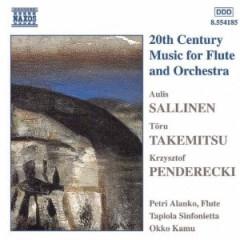Sallinen, Takemitsu, Penderecki – 20th Century Music for Flute and Orchestra (1999)
Sallinen, Takemitsu, Penderecki – 20th Century Music for Flute and Orchestra (1999)

Aulis Sallinen Concerto for flute and orchestra, Op. 70 "Harlekiini" (21'42) 1 Allegro - (6'04) 2 Adagio - (4'27) 3 Allegro - (4'20) 4 Adagio (6'52) Toru Takemitsu Toward the Sea II for alto flute, harp and strings (12'07) 5 The Night (3'46) 6 Moby Dick (4'26) 7 Cape Cod (3'55) Krzysztof Penderecki Concerto for flute and orchestra da camera (20'17) 8 Andante - (6'33) 9 Andante - (3'24) 10 Allegro con brio (10'20) Petri Alanko - flute Tapiola Sinfonietta Okko Kamu – conductor
Aulis Sallinen is among the best known contemporary Finnish composers. His Concerto for flute and orchestra, Opus 70, commissioned by the Finnish Broadcasting Corporation, was completed in 1995 and dedicated to the well-known flautist Patrick Gallois. The concerto, given the title Harlekiini, is scored for four string quartets, six brass-players and a number of wind and percussion instruments, the last placed mid-stage to give a stereophonic division between strings and brass. It is in four connected sections and opens with evocative orchestral sonorities, before the entry of the solo instrument into what are firmly tonal textures. To the orchestral chords the flute adds fragments of melody, based on recurrent figures and motifs, passed from soloist to orchestra. The Adagio section that follows harsh accompanying tone-clusters, offers an element of relative tranquillity, the flute solo now accompanied by dense orchestral chords and by a percussion counterpoint. The third section is introduced by the soloist, after the interweaving of the flute and solo violin line. Related material, sometimes angular in outline and often fragmentary in form, is passed between the participants, varying in mood from the meditative to the energetic, before a gong initiates the fourth and final section. Here a prolonged flute solo, suggesting a cadenza, leads to the return of the orchestra in all its varied instrumental colourings and to a conclusion that seems to leave much unsaid.
The Japanese composer Toru Takemitsu provides a remarkable conjunction of East and West. In the 1960s he began to explore the use of Japanese instruments in a contemporary Western musical context, particularly in works for the biwa (Japanese lute) and shakuhachi (Japanese flute), instruments that he featured in a 1967 commission for the New York Philharmonic Orchestra.
His Toward the Sea was originally written for alto flute and guitar, a combination of instruments that must recall the shakuhachi and biwa which, in the hands of some modern Japanese composers have something of Ravel or Debussy about them. Takemitsu's work was arranged in a second version for alto flute, harp and strings and first performed in this form in Sapporo in 1981. As so often, poignant use is made of silence in all three movements, with their subtle nuances of flute tone. Although the movement titles suggest the work of Herman Melville, the music itself paints another picture. Takemitsu himself spoke of his music as fragments thrown together, as if in a dream, creating imaginary soundscapes, be it the serenity of night or, as in the third movement, the evocative dawn over the tranquil sea.
Penderecki's Concerto for flute and chamber orchestra was completed in December 1992 and is in one continuous movement, although the tracks given mark some of the changes in mood. It is scored for a varied orchestra with an extended percussion section and is dedicated to Jean-Pierre Rampal. Penderecki is eclectic rather than doctrinaire in his choice and use of musical materials and makes considerable use of the varied instrumental timbres available to him, while his writing for the flute itself lacks the varied nuances that Takemitsu could derive from Japanese and Chinese musical tradition.
A clarinet starts the concerto, presenting fragments of melody to which the solo flute responds and which will form the basis of what follows. A passage for flute alone ends in a short chromatic melodic figure that is inverted and explored as the music increases in momentum. A flute cadenza is followed by a passage marked Vivace in which the two melodic figures, one angular and wide-spaced and the other chromatic, are featured. There is an intervention by the trumpet and suggestions of Baroque counterpoint, which are to return. Track [9] of the present recording is marked Andante and offers a moment of rest and poignancy in its descending melodic line and its oscillating flute octaves. There is an increase in harmonic tension before the energetic Allegro con brio, with its fierce tom-tom accompaniment. The flute, following the percussion, introduces a further melodic fragment for development. An Adagio brings, as at the beginning of the work, a duet between a clarinet and the soloist, but the pace soon increases, bringing a passage for solo flute, briefly accompanied. An angular Vivace offers music of increased ferocity and then interrupted passages of Andante recitativo for the flute. The oscillating octaves and descending melodic line of the central Andante return and it is in this mood of melancholy that the work ends, with a final resolution on a chord of G, its major third implied. ---Keith Anderson, naxos.com
download (mp3 @320 kbs):
yandex 4shared mega mediafire zalivalka cloudmailru uplea ge.tt








